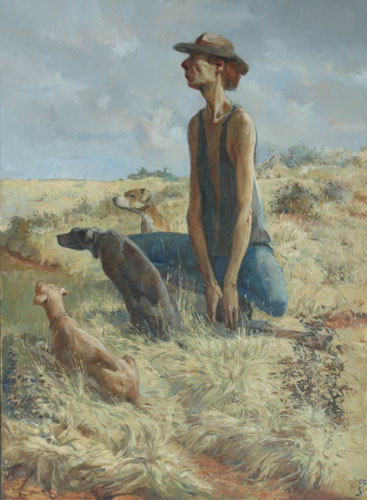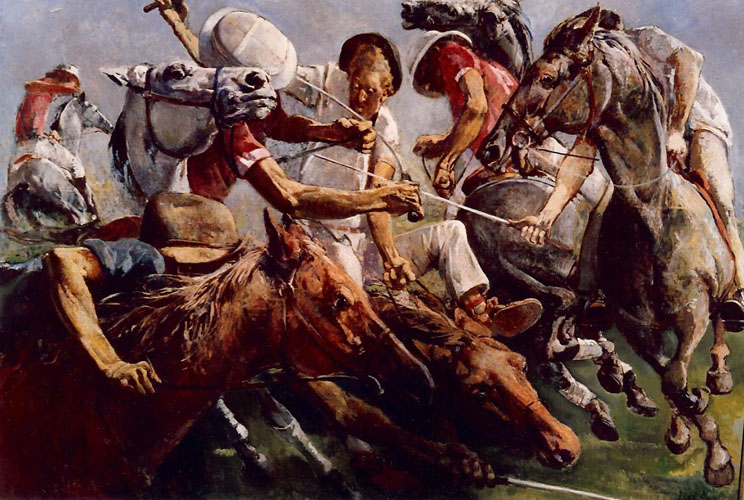About John Beeman
John Beeman was born in Sydney Australia on the 5th May 1926 the son of a Church of England minister and the youngest of eight children he grew up in Manly on Sydney's northern beaches. In 1945, after completing war service with the RAAF 102 squadron as an air gunner, he enrolled at Julian Ashton's art school where he studied painting and drawing under the tuition of Henry Gibbons. In 1949 John began working at the Australian Museum. In 1950 he received a private grant to attend London University to study painting and drawing at the Slade School of Fine Art, and art restoration and art material chemistry at the Courtauld Institute. During this period in London he received a Sigmund Goethe grant which alleviated some of the financial burden of the full time student and allowed him to concentrate on his studies. He also took the opportunity whilst at the Slade School to take courses in archaeology, a subject that related to his employment at the Museum.

On his return to Australia in 1952 John married his fiancé Rosemary Hain, an art student at East Sydney Technical College, John and Rosemary went on to have three children and are still happily married to this day. In 1952 John also resumed his position at the Australian Museum and in 1956 he was asked to head the newly established Art/Exhibitions department and was tasked with assembling a team of suitably qualified artists and designers to staff the new department . This was the beginning of a new era for the institution in bringing the Museum’s extensive and diverse natural history collection to the public in a new way. The direction was now to create well designed exhibitions that engaged and educated the viewer by presenting the Museum’s collections in context with the inclusion of educational material and presented with the use of visual narrative. By presenting specimens and information in a carefully designed, well displayed and visually exciting environment, and placing the focus on informing the viewer, the institution moved from the Victorian era of displayed curiosities and labelled specimens in show cases to the educational institution that we now associate with The Australian Museum.
In 1962 the Museum sent John on a 3 month study tour of the United Stated to investigate the exhibition methods and techniques that were being applied by the major American natural history institutes. On his return John was instrumental in introducing to Australia for the first time numerous display techniques that he had been exposed to in the U.S. Significantly, among these was the photographic silkscreen techniques that visual artists such as Sally Robinson later developed into the creative artistic medium that define her print making. Under the leadership of John Beeman, the Australian Museums Exhibition Departments influence on museum display techniques set a new standard for exhibitions that was quickly adopted by all the leading Australian public museums.
In 1969, after 20 years at The Australian Museum John was offered a position at the NSW National Parks and Wildlife Service, as head of the Interpretations Division. This section dealt with publications, public relations, education, exhibition and display. The role of the Interpretations Division was to produce and present this material to the general public by, among other methods, the establishment of the now familiar network of visitors centres at the major National Parks throughout NSW.
Throughout the years at the Museum and National parks John painted, whenever time permitted, in his studio at home. Over these years he entered and won numerous local exhibitions and in 1975 he won the Grace Brothers art competition, grand prize and traditional sections and in 1976 the Tooheys Paint a Pub competition. These successes were encouraging to John as he found the position at NPWS had become largely administrative and his genuine passion to create art was far from being satisfied, to this end, in 1979 he took 2 years long service leave with the objective of establishing himself as a full time artist. In this venture he was successful enough to take early retirement after his 2 years leave and support himself and his wife Rosemary largely on the income derived through the sale of his paintings.
At this time John and Rosemary moved to the Hastings Valley on the NSW mid north coast where they were both able to paint full time. After moving to the Hastings Valley they gathered support from the local art community to establish the Hastings Valley Fine Art Society and during this period also conducted residential art schools at their property near Wauchope where John instructed small groups of students (young and old) in the various aspects of painting with oils.

As one would expect, the disciplines and techniques that John learnt at Ashtons, the Slade school and the Courtauld Institute have given him a firm grounding in traditional oil painting and a thorough understanding of the theory and history of traditional and contemporary fine art. His subject matter varies widely although his focus over the years has been people, in and of their environment. He portrays his subjects with keen observation and at times a sharp and subtle wit. Johns subjects can perhaps be best described as ‘the art of every day life in Australia’ past and present. Restaurants, court rooms, funerals, weddings and rural life are just some of the diverse subjects that inspire Johns art and the characters he portrays are always represented with an elegant drama that provokes the viewer to think about the lives and thoughts of the subjects he portrays.
John has an extremely disciplined approach to his painting. His method is without fault when it comes to his technique. He paints exclusively on panels prepared with traditional rabbit skin gesso ground and, in the tradition of the early European artists, develops his work by underpainting, tonal modelling and glazing resulting in finished work that has atmosphere and luminosity that direct painting can rarely, if ever, achieve. There is nothing quick about Johns work and the end result of this approach is a body of work that, apart from its artistic merit, has archival quality that will ensure that it will endure.
Since he decided to take up painting full time in the late 70’s there has rarely been a time when he could not be found in his studio working on his next piece, as a consequence his body of work is prodigious and can be found gracing hundreds of walls in Australia and overseas. For the past 10 years he has almost exclusively exhibited his work through the Red Hill Gallery in Brisbane and without exception every exhibition there has been ‘sold out’.
John is a private man and has never shown much interest in persuing a public profile - some would say he has actively avoided it - beyond that which was necessary to make a living selling his work through exhibition. In taking this approach he has deliberately avoided the expectation that comes with celebrity and this has allowed him to choose and express his subject matter and live his life without the dictates and compromise that often arise from having a more visable ‘public profile’. John has an enthusiastic following of collectors and admirers and has always been happy to make himself available to instruct and encourage students of painting, amateur or professional in the techniques of painting with oil. Wherever he has lived he has tutored, mentored and encouraged art societies, painting groups and individual painters from all over the east cost of NSW and Qld. To this day he can be found regularly instructing individuals and groups in his studio in Yamba in the techniques and methods of painting and drawing that he is now so familiar with; he does this not for money but rather to share his knowledge with those who are interested and to enhance their ability to produce quality art.